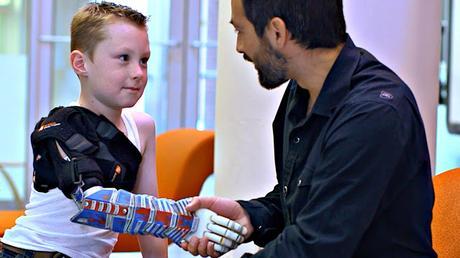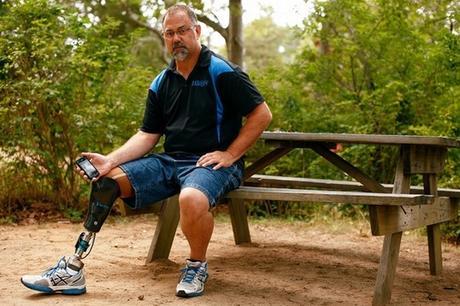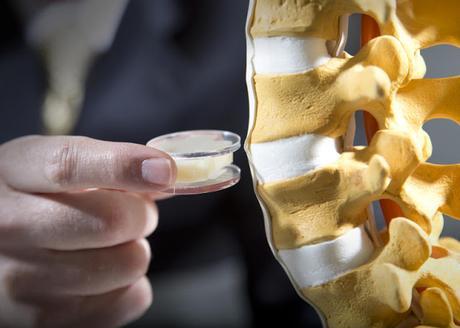 Artificial limb prosthetic are artificial extensions
that replace the missing limbs- arms or legs which are lost due to disease,
mishap, infection or congenital defects. The artificial limb prosthetics are
part of bio mechanics which deal with the science of fusing the mechanical
devices with nervous system, human muscles and skeleton for enhancing or
assisting the motor control lost by disease, defect or trauma. The type of
artificial limb prosthetics which is used will be determined by the location of
the missing extremity and extent of an amputation or loss.
Type of prosthetics
Artificial limb prosthetic are artificial extensions
that replace the missing limbs- arms or legs which are lost due to disease,
mishap, infection or congenital defects. The artificial limb prosthetics are
part of bio mechanics which deal with the science of fusing the mechanical
devices with nervous system, human muscles and skeleton for enhancing or
assisting the motor control lost by disease, defect or trauma. The type of
artificial limb prosthetics which is used will be determined by the location of
the missing extremity and extent of an amputation or loss.
Type of prosthetics
- The types of prosthetics are-
- Artificial upper limb prosthesis
- Artificial joint prosthetics
- Trans-radial prosthesis
- Trans-tibial prosthesis
- Artificial lower limb prosthesis
- Trans-femoral prosthesis
- Robotic prosthesis
- Cosmetic prosthesis
 A prosthesis will look
however you want it from purely functional look of the mechanical parts to a
cosmetic cover which looks like a natural limb. If you want to make it a
fashion statement, you can have your socket covered in the favorite team’s
logo or accessorize it with the favorite color or pattern. Technology
continues changing the artificial limb prosthesis market and with advanced in the
microprocessor foot and knee, advanced sockets and hands, they continue to
offer new opportunities to improve the lifestyle of people with limb loss.
Who need a Prosthetics?
A prosthetics is a took
an artificial replacement for a missing limb or part of a limb which can help
to regain the independence after your amputation. Choosing to use one or not
will depend on the personal goals and the best prosthesis is one which help to
reach your goal. Some important things to ask yourself to help find the best
prosthesis are- what do you want to be able to do with the prosthesis? Do you
want o walk or run? What activities do you plan to do? Do you care about the
way it looks?
There is no one device that is best for everyone;
therefore you should work with your doctor, therapists, prosthetic to address
your needs and concerns. The prosthesis will work with you on design and fit
and the physical and occupational therapist will work to teach you how to use
your new prosthesis.
How is New Prosthetics Constructed?
Each device will be
different depending on the level of your amputation, needs and physical
ability. The prosthetist will create a device which is custom made to fit you.
He/she will suggest based on the type of amputation and your activity level. The
last few decades have seen magnificent advancement in new prosthetics and news
material like carbon fiber have made them lighter, stronger, limiting the
amount of extra energy to be put for operating the limb.
Creating life-like limbs called as cosmetics are made
out of silicone or PVC. These prosthetics look like real hands with complete
veins, fingerprints, hair, freckles and even tattoos. The cosmetics can be
attached to the body using an adhesive, suction or a skin sleeve, form-fitting,
stretchable skin.
How is Artificial Limb Prosthesis Surgery Performed?
The Affordable Cost artificial limb prosthesis surgery in India is performed as a direct skeletal fixation, socket, pylon
and suspension. During the direct skeletal fixation, a metal implant is
inserted into the center of the bone of the stump through skin. A prosthesis
will be then attached into this metal implant. The aim of this procedure is to
securely attach the prosthesis limb comfortably.
A pylon is an internal frame or skeleton of prosthetic
limb providing structural support and formed of metal rods. They are enclosed
by a cover made up of foam like material that can be shaped or colored to match
the patient’s skin tone for a lifelike appearance. A socket is the portion of a
prosthetic device that interface with the patient’s limb stump and it is
crucial to be fitted since the socket transmits forces from the prosthetic limb
to the patient’s body to carefully eliminate irritation or damage to the skin
or the underlying tissues. A suspension
will keep the prosthetic limb attached to the body.
A prosthesis will look
however you want it from purely functional look of the mechanical parts to a
cosmetic cover which looks like a natural limb. If you want to make it a
fashion statement, you can have your socket covered in the favorite team’s
logo or accessorize it with the favorite color or pattern. Technology
continues changing the artificial limb prosthesis market and with advanced in the
microprocessor foot and knee, advanced sockets and hands, they continue to
offer new opportunities to improve the lifestyle of people with limb loss.
Who need a Prosthetics?
A prosthetics is a took
an artificial replacement for a missing limb or part of a limb which can help
to regain the independence after your amputation. Choosing to use one or not
will depend on the personal goals and the best prosthesis is one which help to
reach your goal. Some important things to ask yourself to help find the best
prosthesis are- what do you want to be able to do with the prosthesis? Do you
want o walk or run? What activities do you plan to do? Do you care about the
way it looks?
There is no one device that is best for everyone;
therefore you should work with your doctor, therapists, prosthetic to address
your needs and concerns. The prosthesis will work with you on design and fit
and the physical and occupational therapist will work to teach you how to use
your new prosthesis.
How is New Prosthetics Constructed?
Each device will be
different depending on the level of your amputation, needs and physical
ability. The prosthetist will create a device which is custom made to fit you.
He/she will suggest based on the type of amputation and your activity level. The
last few decades have seen magnificent advancement in new prosthetics and news
material like carbon fiber have made them lighter, stronger, limiting the
amount of extra energy to be put for operating the limb.
Creating life-like limbs called as cosmetics are made
out of silicone or PVC. These prosthetics look like real hands with complete
veins, fingerprints, hair, freckles and even tattoos. The cosmetics can be
attached to the body using an adhesive, suction or a skin sleeve, form-fitting,
stretchable skin.
How is Artificial Limb Prosthesis Surgery Performed?
The Affordable Cost artificial limb prosthesis surgery in India is performed as a direct skeletal fixation, socket, pylon
and suspension. During the direct skeletal fixation, a metal implant is
inserted into the center of the bone of the stump through skin. A prosthesis
will be then attached into this metal implant. The aim of this procedure is to
securely attach the prosthesis limb comfortably.
A pylon is an internal frame or skeleton of prosthetic
limb providing structural support and formed of metal rods. They are enclosed
by a cover made up of foam like material that can be shaped or colored to match
the patient’s skin tone for a lifelike appearance. A socket is the portion of a
prosthetic device that interface with the patient’s limb stump and it is
crucial to be fitted since the socket transmits forces from the prosthetic limb
to the patient’s body to carefully eliminate irritation or damage to the skin
or the underlying tissues. A suspension
will keep the prosthetic limb attached to the body.
 What happens after surgery?
After the surgery, you
will the recovery time will depend on how quickly the residual limb will fully
heal. Some people will get a temporary prosthesis immediately post amputation to
within two to three weeks post surgery. Often a prosthetic fitting will start
two to six months post surgery when the surgical incision has healed, swelling
went down and the physical condition improves.
Why India is Best Place for Artificial Limb Prosthesis
Surgery?
India has been
recognized as a new medical destination for artificial limb prosthesis surgery
due to low cost, highest quality medical service, care to the global patients
from across the world. At Forerunners Healthcare Consultants, we have
association with the highly qualified, skilled surgeons with many years of
experience, the top hospitals with advanced medical equipments and
technologies, medical experts to help patient with post treatment recovery.
Send us your inquiry to know more about low cost artificial limb prosthetics in
India.
What happens after surgery?
After the surgery, you
will the recovery time will depend on how quickly the residual limb will fully
heal. Some people will get a temporary prosthesis immediately post amputation to
within two to three weeks post surgery. Often a prosthetic fitting will start
two to six months post surgery when the surgical incision has healed, swelling
went down and the physical condition improves.
Why India is Best Place for Artificial Limb Prosthesis
Surgery?
India has been
recognized as a new medical destination for artificial limb prosthesis surgery
due to low cost, highest quality medical service, care to the global patients
from across the world. At Forerunners Healthcare Consultants, we have
association with the highly qualified, skilled surgeons with many years of
experience, the top hospitals with advanced medical equipments and
technologies, medical experts to help patient with post treatment recovery.
Send us your inquiry to know more about low cost artificial limb prosthetics in
India.
